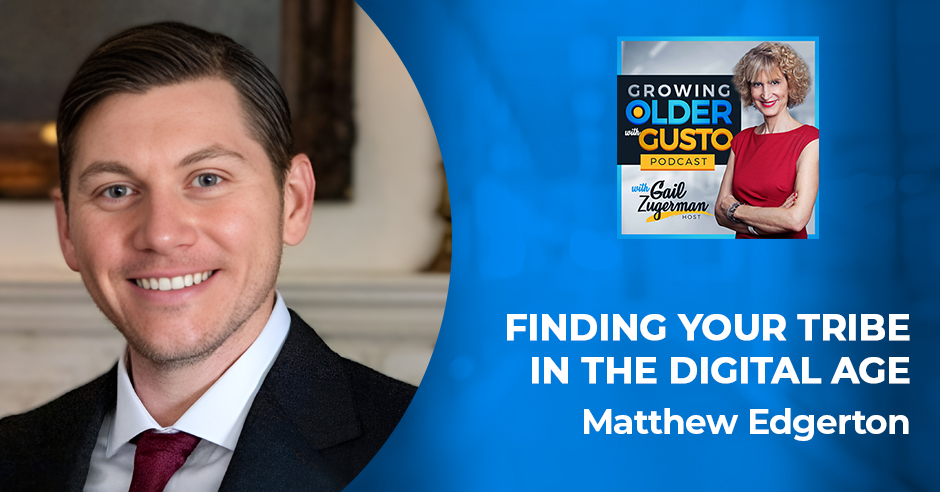
Matthew Edgerton is using personal life experiences and work background to help an aging population find their tribe and grow older with gusto. In this conversation with Gail Zugerman, he shares how he interviewed all types of people, from the aging in independent living to their caregivers and family members, to create his business model called Cogensus. Matthew sheds light on the lack of stimulation among older people and how he strives to determine the best way to get them engaged in life. He also explains how Cogensus uses AI in creating family memoirs that will give people a purpose and something to add to their legacy.
—
Watch the episode here
Listen to the podcast here
Finding Your Tribe In The Digital Age With Matthew Edgerton
Our guest is an enterprising man from California who has been shaped by life experiences to leave the world a better place by helping people as they grow older. His name is Matthew Edgerton, and he’s launching a company in 2025 called Cogensus, which he has created through his background of being a thought leader in the areas of artificial intelligence, innovation strategy, and product development.
Prior to his latest endeavor, Cogensus, Matthew led the global strategy and GTM for the communication and media division of Accenture, Microsoft’s cloud-first practice. Matthew has so much to tell us about how he got to where he is, so I’d like to welcome him to the show. Welcome, Matthew.
Gail, thanks for having me.
How Matthew’s Experiences Shaped Cogensus
You told me you’re shaped by your personal experiences. Let’s start there. Can you tell our readers how this played into you starting your own company called Cogensus? Great name, by the way.
Thank you. The personal experience I referenced was the particular passing of my grandfather. When I was a little guy, I spent a lot of time with my granddad. He watched me a lot from the ages of 1 to 11, when he passed away. My grandpa, I learned later in life, was a pretty exemplary guy. He went through a lot of interesting life experiences. Growing up with him in the context of being his grandchild, I was not exposed to any of that because there are a lot of adult topics you just can’t talk to a child about.
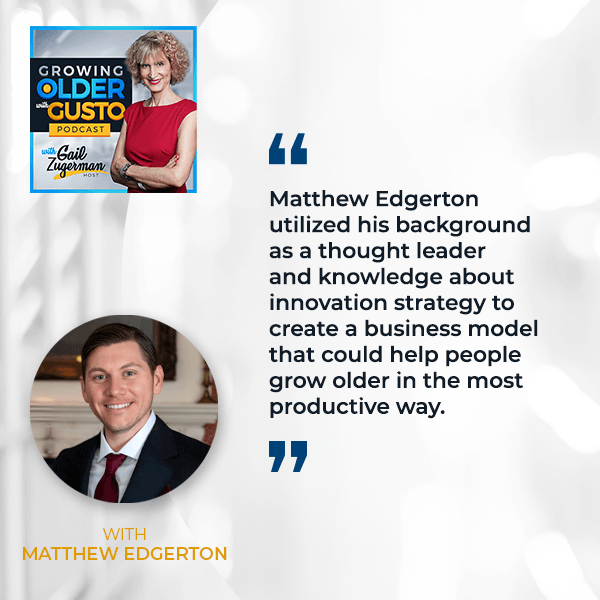
I understand totally.
When I was in my late twenties, I one day stumbled upon his online obituary, and it referenced a couple of things that I didn’t know. I went on a research journey of my own to learn more about my grandpa. I learned that he joined World War II at seventeen. He fought and served and got a Purple Heart and a Silver Star. He came back and tried to commit suicide and then survived. A lot of intense life experiences. It’s a shame that we don’t have more clarity and depth on what happened there.
That colored my experience. In the age of AI, I thought that a lot of people are going to be getting older. It’ll be a real shame if their combined histories pass away without being saved in some form or fashion. That was one of the personal experiences that caused me to move in this direction. This is somewhat professional, but in 2022, I helped the United Nations. I wrote some climate standards for them. You can find it under the ITU group. Effectively, they have these things called SDGs, which are Sustainable Development Goals. There’s a big focus on both preserving the histories of the world.
That could be all kinds of different communities, including indigenous folks, all the way up to helping the world as it ages. That was where I first got exposed to this broader problem about, I’ll call it the aging world that we live in. We are going to be entering a time where we have a lot more people over the age of 60 than under it. That causes a whole bunch of both societal as well as localized changes that need to occur. By taking that into account and trying to be a positive person and leave a positive impact, and then my own personal experiences. That is what shaped Cogensus effectively.
Importance Of Social Connections And Combating Loneliness
There is a lot of talk about the importance of social connections and how it becomes increasingly important as we grow older to maintain and create new connections. Can you talk to our readers about social isolation versus loneliness versus social connectedness?
There are three interrelated but distinct concepts, and we flirt with all of them as people of the world, at any age. Firstly, loneliness is a broader construct. Loneliness is defined in a whole bunch of different ways, but in a very simple way, it’s you feel alone. Whether or not you are physically alone. For example, you feel isolated to some degree. You don’t feel connected with people next to you.
Loneliness can be defined in many different ways. But simply put, it is the feeling of being alone, whether or not you are physically alone.
It’s those whole host of negative feelings that when someone says, “I am lonely,” they could be surrounded by people in a physical sense but feel no relation to them. Typically, loneliness is defined as the interrelated experience between you and I and other people. That feeling is interpersonal. Social isolation is the act of being isolated. That could be a physical or circumstantial situation where you yourself are alone. When you are in a room by yourself, you are isolated.
That can also take place, meaning that you are more isolated from a community, because maybe you live in a rural setting, or maybe, as a lot have happened, unfortunately, people pass away near to you. You become isolated within your localized group. That’s social isolation. Social connectedness is a psychology concept, which is the specific measurement to some degree of your social network.
Social network does not mean social media. Social network means I have two best friends. I have three acquaintances. I have one family member. Those are your relationships. The degree to which you feel connected with those people is social connectedness. For example, there’s a lot of research better understanding social connectedness, because people who score very low on that scale tend to have problems with social isolation as well as the feeling of loneliness.
These three things are now being recognized as health drivers to some degree. They can improve your recovery for something or your chances of readmission for something. These heavily influence those factors. They also, for example, things like cognitive decline, dementia, and a number of other cognitive conditions.
If you are socially isolated, you’re effectively not as engaged with some of those verbal processing things. Those can cause those conditions to speed up in their severity. That’s why it’s very important to focus on these concepts, especially as we age, because we become more exposed to some of these realities of the aging body.
Do you think that people who are naturally introverted or say they don’t need to be around people all the time, or maybe just have a few close friends and that’s it? Do they suffer more health-wise than other people?
It’s interesting because they could be more isolated if we’re talking about social isolation, but they could be less lonely. What they find with the loneliness component is that, I’ll call it the feelings perspective. Social isolation becomes a problem when you think about access to healthcare or access to emergency contacts. That’s why it’s good to live in or near a community potentially just for the physical location of people. However, you could live remote and not be lonely at all.
You could have a very high degree of social connectedness because a lot of that is self-reporting. You could say, “I feel very connected to my sister who lives across the country. We talk every day.” You might not have those negative perceptions. That’s one of the things that I feel social media has been very negative for the world over.
In many cases, it can magnify this perception of you feeling alone. Whether or not you’re surrounded by people that may have an interest in engaging with you. I would say, an introvert might be better prepared for some of those concepts, versus an extrovert that derives a sense of purpose or activity from the relationship with other people.
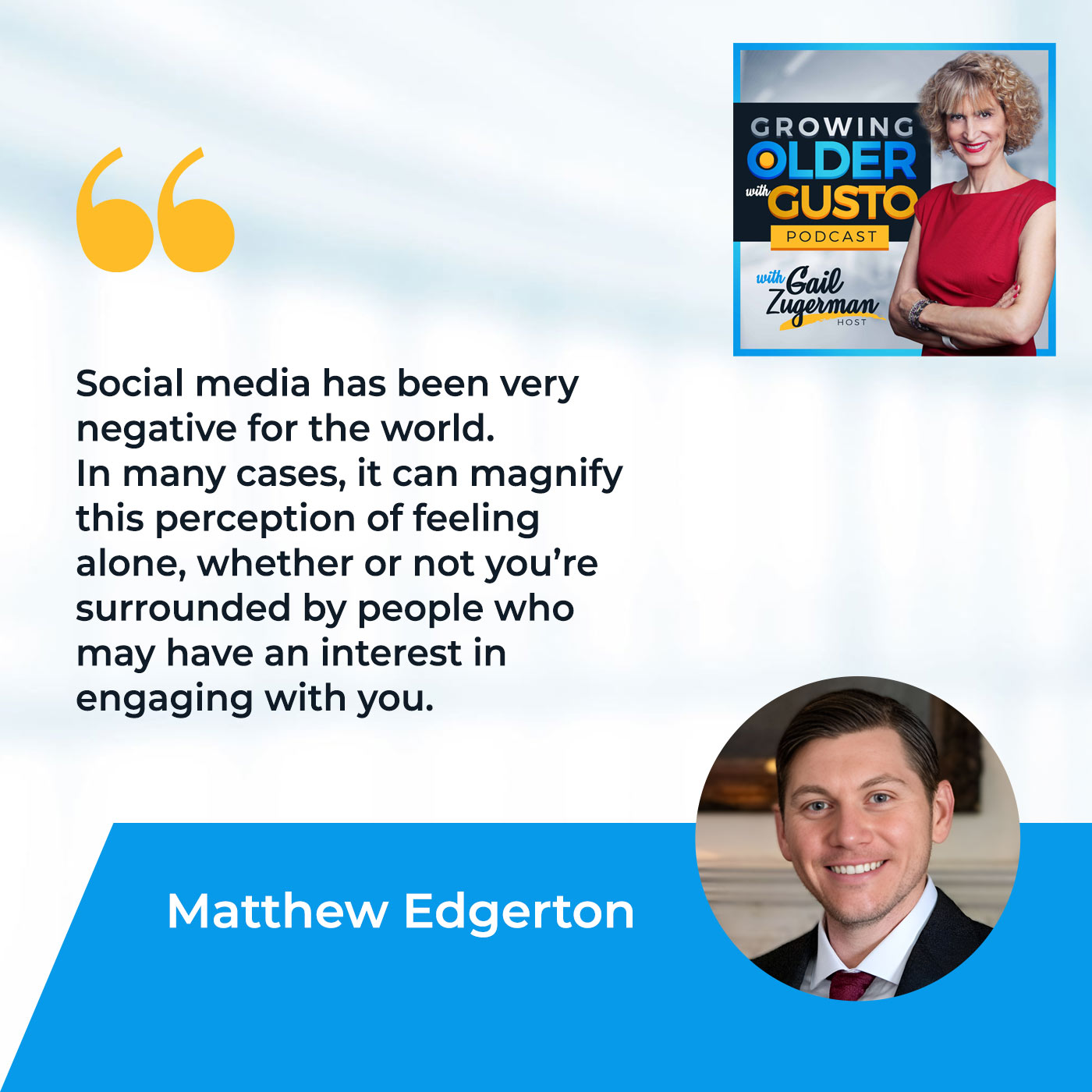
Understanding The Social Determinants Of Health
Tell us, what are the social determinants of health?
Social determinants of health are a concept that have been talked about since 2021, which was when they first made their prime-time appearance. They effectively are non-medical-related factors that influence health outcomes. This is a very broad category. It could be everything from your income to your political outlook to the country you live in. There’s a whole bunch of different things. I believe there are about 14 to 20, and they’re quite easy to find, the list of SDOH. That’s the acronym for it.
Is there some level of importance between them?
Effectively, what they’re finding is that within those SDOH categories, there’s a fair degree of causation or correlation. Depending on how you look at it, to health outcomes meaning some of those are very impactful. For example, loneliness and social isolation are SDOH. As of 2025, now the health community in the United States, the NCQA, which is a regulatory body as far as healthcare reimbursers and payers and things of that nature.
They’ve now formally recognized it in their care standards that hospitals need to collect this. What they’re finding is that people suffering from unrelated conditions, like cardiac readmission or broken arms or legs or limbs. Depending on your standing within these other categories, your chances of improving can heavily go up or down. What they’re finding is those are factors that are both very important from an individual health perspective as well as what they call health economics, which is hospitals knowing if this person might come back.
It’s very important to understand those as people who are caring for others. You could say clinicians, caregivers, or whatever, because those are now on the minds of healthcare professionals. For us as individuals, it’s always interesting to take a look at those SDOHs and just see how you stand because a lot of that is how you feel about those.
Where do you stand?
I’m doing okay. Again, when I say where you stand, it’s how you feel about the categories. For example, we could look at the country you live in as an SDOH, geographic location. For example, just by being in the United States. I benefit from some of the United States infrastructures, whereas that might not apply to someone who lives in a remote province in Southern India or Africa.
They don’t have access to clean drinking water, for example. Maybe looking at something like education. That’s an SDOH. There’s a whole bunch of stuff. It’s effectively where you slot in with these categories. You could argue that a lot of first-world nations will automatically score higher on those things than someone from a more remote, impoverished area.
Finding Your Tribe Vs. Shouting Into The Void Of Social Media
You also speak about finding your tribe versus shouting into the void of social media, which I find fascinating. Can you describe to us exactly what you mean by that?
This is just my words, truthfully. What I mean by that is, if we think about humans broadly and what it means to be connected and supported by your familial or friend ecosystem. I believe that the human brain can only deal with about 50 to 75 connections before we start dropping them. This is a number I read a long time ago. What that means is, you can only maintain so many relationships.
Where you invest that time, it gets dividends back to you from feeling recognized and validated as a person, or if it’s wasted energy. I believe that in the world we now live in, we have moved away from what I would call a healthier path or a healthier outlook to community management. For example, not too in the distant past, your community was the people who were physically near you. You had some level of interaction with your family members and you could identify with certain things like, “We mostly agree on that or this or that.”
Those relationships may be more fruitful from a management perspective because you will get something more out of those, versus what a lot of people have now been conditioned to and are being conditioned to do is focus their energy outward into the broader social community world. This could be someone on the other side of the world, which you could have something in common with them.
The chances of them hanging out with you on a day-to-day basis are very limited. That energy may be going wasted. When we look at things like social connectedness and social isolation, there’s some degree of benefit that comes derived from creating a more localized community. When I say your tribe, back in the day, many years ago.
People who live in the blue zones. That’s one of the main criteria, their tribe or their community around them. I see them every day.
An interesting fun fact is my grandmother-in-law. My wife’s grandmother, lives in Taiwan. She’s 105 and she’s surrounded by family members. As anyone can guess, 105 is pretty old. It’s one of those things where if you look at her lifestyle, it’s very blue zone-ish. She tends to make all her own food at home. She’s got her eight children who take care of her. She’s highly supported. She’s in a localized area and surrounded by her tribe.
All those things are very important. For someone who, let’s say, moved away from their family to a remote area. They never took the time to integrate with the locals. Their community might be a country away and have no localized community. They are very likely to feel isolated in some form or fashion, whether it be socially or physically.
Those become very important for aging with Gusto, as you speak, that you can get out and do things with your communities. The last thing I’ll say about that is it’s always important to cultivate a new community where you go. I think a lot of people get stuck with, “I have these friends from high school,” that’s it. That is very detrimental for aging in place or aging with a better health outcome.
It is always important to cultivate a new community wherever you go. Many people get stuck in their past, which has been detrimental for aging with a better health outcome.
As somebody who moved to a totally new part of the country with my husband, I feel a community, which is what we wanted to do. It does take some time to find your friends and to learn who people are and what people are who you want to be friends with. It takes some time. It’s important for people to know that it’s a process, and it’s worth doing that.
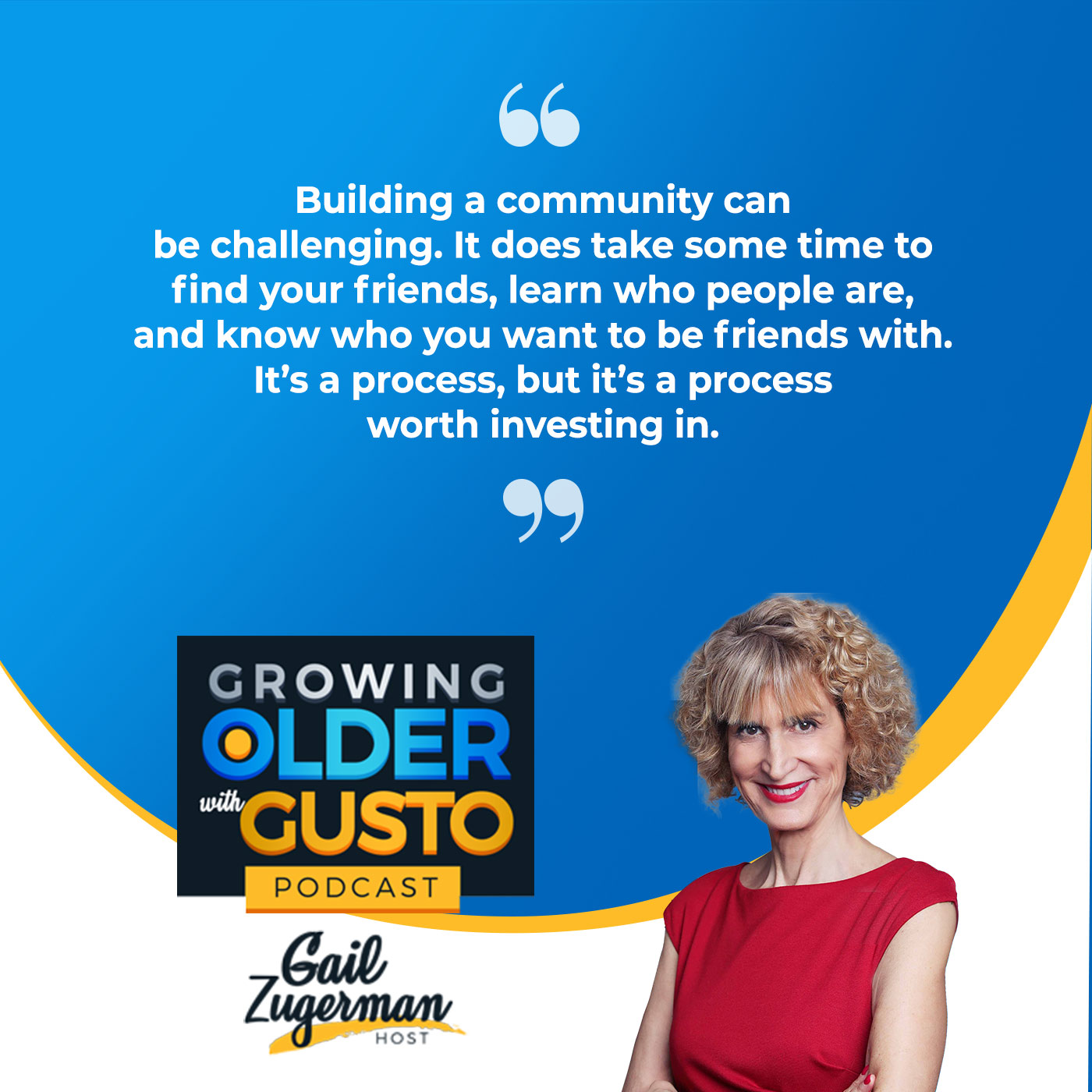
It’s hard. I think everyone recognizes it’s harder to make friends as you get older just because there’s a lot more there. With your children, it’s as simple as, “I have this ball. Would you like to play with me?” The other kid goes, “Yes.” As an adult, you have a lot more accumulated things. I don’t want to call them baggage because it’s not the right word, but history and memories. That process becomes a little bit more tentative, but it is very important to put some level of effort into it because things happen in life. It’s good to have people around you.
How Aging And Social Connections Will Evolve In The Future
We touched on this a little bit earlier, older people in particular, often have trouble maintaining connections because their friends or family members may pass away, move away, or lose their hearing. How do you see this changing in the future?
There’s two ways to look at this. There’s a pessimistic outlook and an optimistic outlook. I’ll give a little of both. The pessimistic outlook is if you look at the world’s population, and I just use this broadly. We have a lot of folks getting older or living longer. They’re not having as many children. Their children are not having as many children.
This is pretty consistent across a lot of first- and second-world economies in the world. Some places are hit very badly. For example, Asia has a huge problem with this. The US is tracking a little bit behind, but still going in that direction. I think it’s by 2050, about 20% of the population will be over 65, which is a dramatic number when you think about historical context. What that means is there are going to be a lot more people passing away.
At the same time, there are going to be a lot more people aging in similar circumstances. That gives them the capability to form friendships in a more like-to-like comparison, potentially. People around you are experiencing a similar transition, a similar journey in life. There will be something you could identify and be friends with. As we go a couple of generations forward, I think the younger generations may have a bigger problem. The biggest takeaway from that is you need to keep an open spirit. This is a problem that I find. This is one of my personal critiques of social media broadly.
Social media effectively finds what causes us to have a strong emotional reaction. Oftentimes, that’s negative, and it seeks to magnify those things because they’re looking for engagement. At the end of the day, how they get paid is when you click the link and you spend time in the whatever. It could be the news, an article, or videos. It doesn’t matter. Those topics are not often good for you. We have much more negative content output than positive because negative just moves faster.
People like to rage to themselves. That mindset is very negative because it causes a closing effect. You effectively close yourself off from new experiences and new people. By doing that, you’re only harming yourself. It’s a personal thing we all have to take some level of responsibility for. The best advice is you’ve got to keep an open mind and remember that we’re not so different across age brackets, ethnicities, all of the above.
Ways To Combat Loneliness And Isolation In Older Adults
Aside from maybe living in a closely knit community, how can loneliness and isolation be abated for older people? What are some other ways that people can not be lonely and not feel the social isolation?
Social isolation is the trickier one because isolation is generally physical. When it is social and physical, it’s out. With feeling lonely, it’s about understanding your connections. For example, it’s very easy for us to lose touch with someone and think, “I won’t call them. It’s been fifteen years. There’s no reason for me to call,” even if you were very close with them.
The easiest thing you can do is figure out people that you used to enjoy company with. If there wasn’t some horrible schism or chasm that caused you to break apart, reach out to them because they very likely may be thinking the same thing. It takes some level of faith to reach out to someone. Secondarily, this is something that we’re looking to assist in our platform.
We’re going to help by building out effectively these personalized social connection charts that allow you to take an impetus forward and go connect with people that you would like to. Not through our platform, because we’re not social media. We’re just going to give you, “This is what we view based on what you tell us.” That’s one. The last part of this, which is interesting because it sits right next to these things, is purpose.
One of the key things about Blue Zone people and people who tend to live a long time is they have a very clear purpose in life. It’s something they like, it’s something they do and they talk to. It could be a whole bunch of things, but finding your purpose to some degree, the reason to get up and do something every day is what will keep you getting up and doing something every day.
People who tend to live a long time typically have a very clear purpose in life.
Role Of Technology In Fighting Loneliness And Aging
It’s so true. Aside from social media, what do you see as the role of technology in loneliness and getting older?
I think in many ways, outside of a couple of things in tech, that process is going to get a lot better. For example, with Cogensus. We are specifically building our platform to tackle some of those aspects, but what we’re seeing is now with wearables and much more advanced data analytics and proactive monitoring, people who traditionally would have been a victim of a health event in an isolated context have now a way to reach out or they’re being monitored.
We have a much more eyes-on and hands-on approach, where in the past we just didn’t. It wasn’t uncommon to hear someone who lived in a remote countryside was found two weeks later having passed away from an event. Nobody knew. With now the advent of wearables and their mass scale, it’s very easy. The watch you wear every day that tells your time. It could very easily check your heart rate and look for blood sugar. There’s a whole bunch of different things.
Once we start to get into this aspect of what we’re looking at, which is your mental frame of mind, we are entering a new era of how we can better care for someone in this capacity meaning we can start to monitor how you’re feeling in a very altruistic way. When you start to express negativity about your circumstances, in theory in the future, there could be some intervention event where we go, “We recognize you’re at risk for blank. You may want to do this.” It’s not a mandate. It’s something purely for your own benefit. I think it’s very positive overall.
What about artificial intelligence? How do you see that impacting the aging population?
Artificial intelligence is one of those very clear double-edged swords. Artificial intelligence has the capacity to do a lot of good stuff, but in many cases, it will be positioned to do not-so-good stuff. I don’t necessarily think the people designing it are evil. It’s more just a perspective of they’re looking for certain milestones or, as I said, engagement points. Those might not always be rooted in what’s best for you. For example, one of the key things to watch out for in a number of the AI platforms coming out is what they call unhealthy attachments. We’re getting into an age where they can very clearly simulate an avatar that looks identical to you and me.
Artificial intelligence is one of those clear double-edged swords. It has the capacity to do a lot of good. But in many cases, it can be positioned to do otherwise.
I was going to ask you next about robots. How do you feel about robots? I know that people who are older, there are dogs or robotic dogs to help, which I thought was clever.
The robots are far less concerning than some of these digital avatars. The reason I say that is, if someone is older and someone grew up in a very different time. Potentially, they have early stages of cognitive decline of some form or fashion. They might not understand that they’re talking to someone that isn’t real when it looks just like you and me on a health application.
By the way, in the New York Times, there was a long story about a woman who was married who got involved. I don’t know whether it was an avatar, but it was some artificial man online. She’s having a real relationship with. Did you hear about that? It was very bizarre.
I didn’t hear about that one in particular, but that’s not uncommon. That’s probably my biggest. For example, within Cogensus, we do not, at this time, use realistic avatars on purpose. We have a very strong MD psychiatric bend in our technology. We use cartoon avatars on purpose because our intention is not to remove humans from the equation.
Whereas a lot of applications of AI are what I call siloing applications. They’re designed to appeal to you and specifically you and zone in so deeply that you get very attached to it. From a perspective of how we expand social communities and keep you healthy in these outcomes, that is the worst thing you could do.
How Cogensus Can Help People Age With Gusto
Tell our readers more about Cogensus. I want to know more about and understand this business that you’re launching. How is it going to help people age more healthfully and with Gusto?
Our platform is effectively three pillars. These pillars were created based on a lot of field research that I did. Before I launched this company, I went out and interviewed and spoke with a number of people across a whole bunch of different positions. These would be people in active in different kinds of care homes. These could be totally independent senior living.
These could be people who still live in their own home and apartment, like no problem. They’re not in any community. The people in memory care and a whole bunch of things. The caregivers that worked with them, clinicians that supported them, and their family members. I spoke with a lot of people. There were three things that jumped out to us as being very important.
First and foremost, people experiencing loneliness and social isolation are not stimulated on a verbal activity basis on a day-to-day. What happens is they reach out to everyone around them. That could be things as well. To your point, they could start talking with an online chat app. They could reach out to customer service. That’s from a deficit of activity.
The first part of Cogensus is we have an AI-supported journaling feedback engine. Effectively, you can engage with this as if you were talking with you and me. Its function is not to guide you in any particular direction, but rather engage you in communication that stimulates where you want to go with it. The idea being, you talk about how you’re feeling. You can talk about any event. You can just talk. It will engage with you as if you were talking with someone who was getting to know you. Over time, it will get to know you better.
What we do with that is we take those conversations, and we extract indicators around verbal, memory, and mood. Those are the three. We’re looking for indicators about how you’re doing. Those are, when you allow them, shared with your provider. This could be a caregiver, a doctor, or whoever. It has to be a medical professional of some form or fashion. That’s the key part. We’re looking for things like, are you starting to mix up words? Are you misremembering things? Are you just sad? There’s a whole bunch.
A perfect use case for this is the loss of a spouse. This person can be perfectly, physically, and mentally able, but losing a spouse is a very traumatic activity. Especially with regards to social connectivity like you’re connected to your spouse very deeply and typically. That puts you at risk for other comorbidities. It’s very common for people to pass away after their spouse goes. We want to look at that. We want to make sure that you aren’t at risk for negative health outcomes. Those insights are given to your doctor.
The last part, which is a personal interest of mine, but also mirrors back to my broader career, is we give the user and the elderly person, the ability to take those conversations and create pictorial and textual memoirs. They can create memory books about their existence. We AI support that so you can make cool imagery and book entries and all kinds of stuff. Over time, those get packaged. You have this very robust living history of what you want to share. It’s not trying to create you. There are a couple of AI platforms that say, “Give us all your stuff. We’ll recreate you as an avatar.” That’s not our goal.
Do you do that by using photos they share with you or asking questions of them? How does that work?
As I said, when you speak with the AI platform, let’s say you want to talk about your dog, Shirley. You can tell the story about your dog and it will engage with you as if it’s a normal person saying, “Tell me more about your dog. What kind of dog?” The point of that is for you to be able to recollect and say, “Create a memory of my dog, Shirley.” It will give you different options.
You can create a pretty realistic version of your dog, Shirley. You can do that with a sample text effectively to make your book. The reason for this piece of the platform is that one of the biggest things that was called out between family members and people living in communities or by themselves or whatever, was the lack of communication transparency between the family members.
If you’re remotely far, again, you could be isolated but not lonely. We can solve or start to solve some of that, which is, family members want to be able to better engage with their aging relatives in some way. They feel very guilty, traditionally, about having to put them somewhere. The person being moved or transitioning in life is very shocken up. It’s hard and chaotic.
This gives them a way to collaborate on these memories and create these shared family memoirs. The idea being, one of the most important things as someone ages is to know that your life made a difference. The biggest way to do that is to know about the impact you made on yourself and others. You can create that now in our platform.
It sounds like not only are you giving people a purpose, but then you’re creating a bit of a legacy for them too.
That was a big part for me because, again, this calls back to my grandpa. If he had this tool, it would be very impactful for he would have created a cool book. Unfortunately, we lost my mother-in-law. She passed away early from cancer. It was very clear as she dealt with the disease how important it was for her to share certain memories and pass on history. Without a tool like this, which is a problem a lot of people are facing. It’s not just us. Everyone has a story or two about this.
It’s very hard to capture all those memories in a singular instance, especially when you’re engaging in long-term care of some sort. Those memories are typically 30 seconds to a minute shared in passing and they’re gone. Without a tool that can quickly capture those and then later help you import and create those. They go into the ether. That’s why that function, of all the functions is the most important to me from what I call a social good perspective.
Matthew, it sounds like you’ve done something good here in creating Cogensus. I would like to let our readers know how to reach you or how to learn more about Cogensus, more than we could share in this short episode.
We are trying. We’re building something that we believe will be impactful for the world over. It’s as simple as going to www.Cogensus.com. That’s how you get there. You could reach out to us through the website. Our intention is to go live with the product for our early test in August of 2025. We hope after that, you will start to see it in the market.
At that point in time, we are also working with insurance companies to allow this to be reimbursable. Our goal is to make this available to as many people as possible out the gate. Our current model is that we sell through healthcare institutions and senior care communities. Once we’re live, you could get that, ask your providers to look into what we’re doing and then they can help procure that for you.
Thank you, Matthew. This has been a great episode, and thank you for reading this show. If you’d like to learn more about our show, please go to www.GrowingOlderWithGusto.com or check out our YouTube channel. Remember to stay curious and stay connected.
Thank you, Gail.
Important Links
- ITU
- Matthew Edgerton on LinkedIn
- Cogensus
- Gail Zugerman on LinkedIn
- Growing Older with Gusto
- Growing Older with Gusto on YouTube
About Matthew Edgerton
 Matthew had 15 years experience as a leader of Global Strategy and GTM for Comms & Media Division of Accenture’s Microsoft’s Cloud First Practice.
Matthew had 15 years experience as a leader of Global Strategy and GTM for Comms & Media Division of Accenture’s Microsoft’s Cloud First Practice.
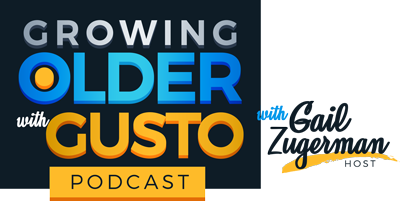

0 Comments